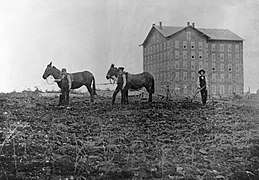Penn State College of Agricultural Sciences
The Penn State College of Agricultural Sciences offers 17 undergraduate majors,[1] 23 minors,[2] and graduate programs in 18 major areas.[3] The college awarded the nation's first baccalaureate degrees in agriculture in 1861.
| Type | Public |
|---|---|
| Established | 1861 |
Parent institution | Pennsylvania State University |
| Dean | Richard Roush |
| Location | , , 16802 |
| Academic Departments |
|
| Facilities |
|
| Website | agsci |
With 9 academic departments and 67 cooperative extension offices, one in each of Pennsylvania's counties, the college is widely recognized as one of the nation's top institutions for agricultural research and education programs.
History

In 1855, before the Penn State College of Agricultural Sciences, it was a high school known as The Farmer's High School run by Evan Pugh. Pugh helped to transform the Farmer's High School into the Penn State College of Agricultural Sciences by supporting Congress to pass the Morrill Land-Grant Act. The only land-grant university in Pennsylvania, Penn State became one of the nation's very first when President Abraham Lincoln signed the Morrill Act into law in 1862. As a result, government receives money from the sales of land to help fund a college that would teach people better farming methods. In addition to learning farming methods, Pugh had contributed other subjects to the college including chemistry, geology, mathematics, and mineralogy. Not only did he contributed knowledge to the college but he also donated money towards the laboratory buildings and research. Pugh died on April 29, 1864. Today, he is known as the first President of The Pennsylvania State University and the highest award a professor can receive at the university is named after him which is called the "Evan Pugh Professors."
Academics
Undergraduate students can choose from 17 majors, 24 minors, and three two-year associate degree programs. Graduate programs are offered in 18 major areas within the college, and faculty participate in 10 inter-college programs and seven dual-title degree options.
Academic departments
The college is organized into nine academic departments:[4]
|
|
Research
The Penn State College of Agricultural Sciences invests nearly $97 million in research and graduate study yearly. Scientists in the college are seeking solutions to the agricultural and ecological problems of our time by conducting basic and applied research focusing on cross-cutting thematic areas.
Enrollment
- Approximate total college undergraduate enrollment: 3,000
- Approximate college undergraduate enrollment at University Park campus: 2,100
- Total college graduate student enrollment: 580
Scholarships
- The college has one of Penn State's largest scholarship programs, awarding nearly $2 million to nearly 700 students annually.
Contributions
- The Penn State College of Agricultural Sciences has made many contributions in recent history. One example includes Penn State's research in unraveling the mystery of Colony collapse disorder (CCD). CCD is when bees suddenly disappear and do not return to their hives. Bees are important in producing honey and also pollinating plants. The E.B. O'Keeffe Foundation donated $100,000 to Penn State for research in CCD.[5]
- Penn State is also making contributions towards protecting water quality. Fresh water is a limited resource, and Penn State is doing research to improve and sustain our fresh water resources. Water could become scarce someday, becoming the next generation's new oil.
- There are countless other amounts of research and contributions that Penn State is making to the world.
See also
References
- "Undergraduate Majors". Penn State College of Agricultural Sciences. Retrieved April 24, 2015.
- "Undergraduate Minors". Penn State College of Agricultural Sciences. Retrieved April 24, 2015.
- "Graduate Programs". Penn State College of Agricultural Sciences. Retrieved April 24, 2015.
- "Academic Departments". Penn State College of Agricultural Sciences. Retrieved April 24, 2015.
- "O'Keeffe Foundation gift will enhance Penn State honeybee research". Penn State News. Retrieved May 20, 2015.